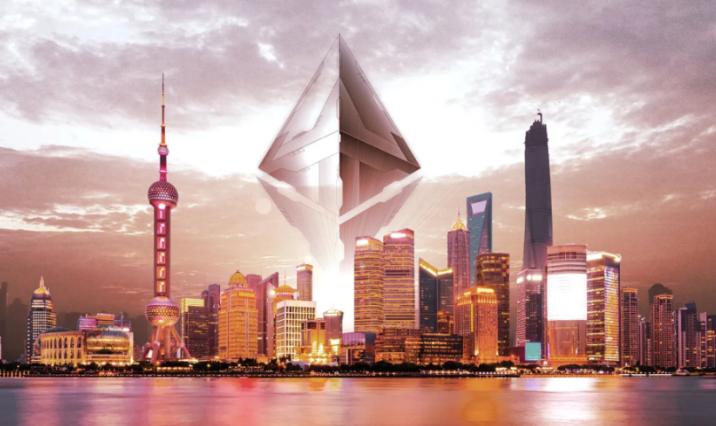A Review of the "Past and Present" of the Ethereum Shanghai Upgrade
Author: Hashkey Group
(Article published in February)
Have you heard about the Ethereum Shanghai upgrade? Do you know the specifics of this significant upgrade? The Ethereum Shanghai upgrade is another major event in the development of the Ethereum blockchain following the Ethereum Merge. The Ethereum Merge in September 2022 allowed the blockchain network to transition to a Proof of Stake (PoS) consensus mechanism. One of the key focuses of this Shanghai upgrade is to allow Ether (ETH) stakers to withdraw their Ether. Below, we will provide a detailed introduction to the main content of the Ethereum upgrade, the specific implementation timeline, and the question that many are concerned about: What impact might the Ethereum Shanghai upgrade have on investors and the market?
What is the Ethereum Shanghai Upgrade?
As a significant update to the Ethereum blockchain, one of the main goals of the Ethereum Shanghai upgrade is to allow Ether (ETH) that has been staked in the Ethereum Beacon Chain smart contracts to be withdrawn. The Ethereum Merge implemented in 2022 enabled Ether holders to lock their Ether in the smart contracts of the Ethereum Beacon Chain. With the successful completion of the Shanghai upgrade, a large amount of Ether can be unlocked, and the impact on blockchain development and the market is worth noting; it is undoubtedly a major event of the year.
Background: The Ethereum Merge and Proof of Stake Mechanism
The Ethereum Merge completed last year was a significant upgrade successfully implemented by the Ethereum community after years of development and testing. In 2020, Ethereum launched the Beacon Chain, which adopted a Proof of Stake consensus mechanism, allowing the Beacon Chain to operate in parallel with the Ethereum main chain. The so-called "Proof of Stake" consensus mechanism allows the blockchain network to operate without relying on miners; instead, network nodes lock up cryptocurrency to maintain normal network operations and process transactions.
After the Beacon Chain successfully operated for a period, the Ethereum blockchain smoothly merged. In simple terms, the Ethereum Merge combined the original execution layer of Ethereum with the new Proof of Stake consensus layer (the "Beacon Chain").
Under the Ethereum Proof of Stake mechanism, one of the thresholds to become a node that validates transactions and produces blocks on the Ethereum network is to lock (also known as "staking") at least 32 Ether (ETH) through Ethereum smart contracts. On the other hand, several staking service providers have emerged in the market, allowing users to delegate their Ether to be locked by the service providers in exchange for rewards. Under the Proof of Stake mechanism, validating nodes are responsible for verifying transactions and ensuring the normal operation of the Ethereum blockchain. This design allows the blockchain network to avoid relying on the energy-intensive "Proof of Work" mining model, aiming to reduce Ethereum's energy consumption by over 99.9%.
The technical difficulty of the Ethereum Merge was immense, comparable to changing the engines of a rocket while it is still flying. On September 15, 2022, Ethereum successfully executed the merge. After completion, Ethereum welcomed its next major update: the Shanghai upgrade, primarily aimed at allowing staked Ether to be withdrawn.

Proof of Stake: The Making of Ethereum and the Philosophy of Blockchains, Author: Vitalik Buterin
History of the Shanghai Upgrade: Ethereum Founder Vitalik Buterin and HashKey Chairman Dr. Xiao Feng
The next major upgrade of the Ethereum blockchain, codenamed "Shanghai," reflects the deep connection between Ethereum and the city of Shanghai.
As background on the Ethereum blockchain upgrades, since its launch in 2015, the Ethereum blockchain has implemented several significant upgrades: Byzantium (2017), Constantinople (2019), St. Petersburg (2019), Istanbul (2019), Berlin (2021), and the London upgrade (2021).
These upgrade codenames are named after the cities that hosted the annual DevCon conference organized by the Ethereum Foundation. As for the codename of the next major upgrade, as pointed out by Dr. Xiao Feng, Chairman of HashKey Group, it naturally comes from the Shanghai DevCon conference held in 2016 and a historical event that occurred that year. A year before the Shanghai DevCon conference (in 2015), HashKey Group, through its subsidiary, invested in Ethereum and became one of its early investors.
Dr. Xiao Feng, Chairman of HashKey Group, was previously invited to write a preface for the Chinese version of the book The Infinite Machine, where he mentioned his collaboration experience with Ethereum co-founder Vitalik Buterin. In April 2015, Vitalik came to Shanghai, and the two met for the first time.

Dr. Xiao Feng, Chairman of HashKey Group
In the early stages of Ethereum's development, Dr. Xiao Feng had in-depth discussions with Vitalik Buterin on how to accelerate the application of blockchain technology in China. In 2015, Dr. Xiao Feng, under the name of Wanxiang Blockchain Lab, funded Ethereum with $500,000. This investment practically helped Ethereum get back on track in its blockchain development direction. Since then, Vitalik Buterin and Dr. Xiao Feng have continued to work closely together, including actively participating in the annual Wanxiang Global Blockchain Summit and the 2016 Shanghai DevCon conference.
In the preface of Point to Everything: Ethereum and the Future of Digital Finance, Dr. Xiao Feng stated: "The Merge is not only an important moment in the history of Ethereum's development but also a pivotal moment in the history of blockchain technology development!"
"After The Merge, Ethereum can also support large-scale applications in terms of performance and scalability. According to the Ethereum Foundation, within 10 years, Ethereum will be able to achieve a transaction processing capacity (TPS) of 10 million transactions per second. Based on my personal observations, analogous to the development process of internet protocols, in the coming years, blockchain protocols will gradually be pushed by market forces towards a unified protocol stack; other public chains outside of Ethereum may become Ethereum's sub-chains, side chains, or shards, achieving an ideal interconnected blockchain world." -- Dr. Xiao Feng, Chairman of HashKey Group.
Ethereum Shanghai Upgrade: What Impact Will It Have on Stakers and Investors?
The focus of the Ethereum Shanghai upgrade is to allow stakers to withdraw their staked Ether (ETH).
With the implementation of the Proof of Stake (PoS) consensus mechanism, Ether holders can obtain the qualification to participate in validating the Ethereum network by staking a certain amount of Ether.
Since its launch in 2020, the Ethereum Beacon Chain has begun accepting Ether staking.
In 2022, Ethereum developers decided not to include the feature of withdrawing staked Ether in the Ethereum Merge to focus more on technical priorities. Therefore, stakers on the Beacon Chain have not yet been able to withdraw their Ether or related token rewards.
The amount of Ether staked on the Beacon Chain and the number of stakers have both seen exponential growth.
Withdrawal Limitations for Staked ETH in the Ethereum Shanghai Upgrade
Assuming that after the Ethereum Shanghai upgrade is completed, will there be a situation where a large number of stakers withdraw their Ether? As of the time of writing, the Ether (ETH) staked on the Beacon Chain accounts for over 13% of the total supply of Ether. Since the Ethereum Shanghai upgrade focuses on opening the withdrawal function for staked Ether, as the implementation date approaches, the market is naturally closely monitoring the potential sell-off activities of Ether investors and related market participants. Once it is confirmed that staked Ether can be withdrawn, those who wish to unstake and explore other opportunities will finally have the option to withdraw their Ether. For market participants holding Ether but not staked, the uncertainty of market trends may also prompt them to take corresponding actions.
If all staked Ether on the Ethereum Beacon Chain is suddenly allowed to be withdrawn, will it directly cause large-scale market fluctuations? The answer is unlikely. Because the Ethereum Shanghai upgrade includes withdrawal restrictions and a queuing mechanism. Ethereum will implement a withdrawal limit mechanism for the Ether staked on the Ethereum Beacon Chain, allowing only 6 validating nodes to withdraw staked Ether every epoch, which is approximately every 6.4 minutes. Based on this estimate, after the Shanghai upgrade, Ethereum will only allow about 43,200 Ether to be withdrawn daily.
According to estimates, if all Beacon Chain stakers withdraw their staked ETH tokens, and the number of new stakers is zero, the process will take about 300 days.
Moreover, according to the Ethereum Foundation, the withdrawal rate limit will be adjusted based on the total amount of staked ETH.
When Will the Ethereum Shanghai Upgrade Be Implemented?
According to the plans of Ethereum developers, the Ethereum Shanghai upgrade is scheduled to be launched within 6 to 12 months after the Ethereum Merge. To minimize delays and potential technical issues, Ethereum developers have decided to prioritize the opening of Ether unstaking as a key feature of the Shanghai upgrade, which is the Ethereum Improvement Proposal "EIP-4895: Beacon Chain Push Withdrawals as Operations."
The following is a timeline of the Ethereum Shanghai upgrade development based on publicly available information:
October 2022: In preparation for the Ethereum Shanghai upgrade, Ethereum developers launched a test network codenamed "Shandong" to identify bugs and potential issues.
December 2022: Ethereum developers tentatively scheduled the implementation of the Shanghai upgrade on the Ethereum mainnet for March 2023.
January 2023: At the Ethereum core developer meeting, Ethereum developers confirmed that the Shanghai upgrade would prioritize the launch of Ether unstaking and planned to release the public test network for the Shanghai upgrade by the end of February.
Technical Roadmap After the Ethereum Shanghai Upgrade: Sharding?

Ethereum blockchain upgrade plans and roadmap. Source: @trent_vanepps.
In fact, besides unlocking staked Ether on the Beacon Chain, the Ethereum Shanghai upgrade originally considered including other improvement proposals. However, to reduce the chances of delays, Ethereum developers decided that these proposals would not be included in the Shanghai upgrade.
These proposals include an improvement proposal called "proto-danksharding" (EIP-4844), which is the first step in implementing a sharding architecture for the Ethereum blockchain in two phases. After the successful completion of the Ethereum Shanghai upgrade, the aforementioned proto-danksharding proposal is expected to officially release details later in 2023. If the Ethereum upgrade progresses as planned, the next major upgrade will focus on achieving data sharding upgrades.
In simple terms, the goal of implementing data sharding upgrades is to distribute some of Ethereum's workload across smaller blockchains that work together. Sharding is expected to provide Ethereum with more storage and data access capacity, making the Ethereum blockchain faster and more scalable. At the same time, sharding is expected to lower transaction costs for Layer-2 solutions while maintaining the security advantages of using the Ethereum blockchain.
The sharding upgrade for the Ethereum blockchain is expected to be launched in 2023 and 2024.
Conclusion
The Ethereum Shanghai upgrade will be an important moment in the development of the Ethereum blockchain. This upgrade is named after the Chinese city of Shanghai, naturally reflecting Shanghai's origins and role in the early development of Ethereum. The main goal of the Ethereum Shanghai upgrade is to allow the withdrawal of staked Ether on the Ethereum Beacon Chain, providing stakers with the option to unlock their Ether. The Ethereum Shanghai upgrade is another significant step in enhancing the scalability and decentralization of the Ethereum blockchain and is set to become a major event in the history of Ethereum's development.










